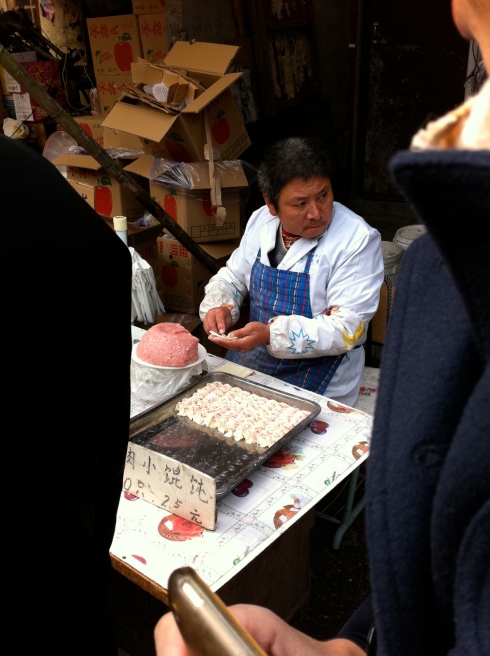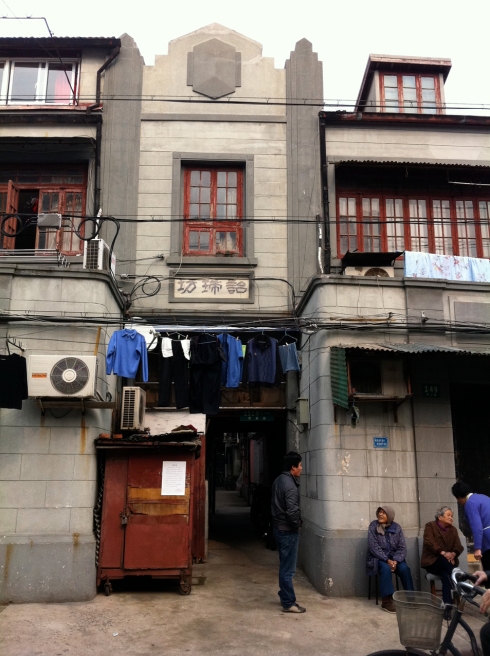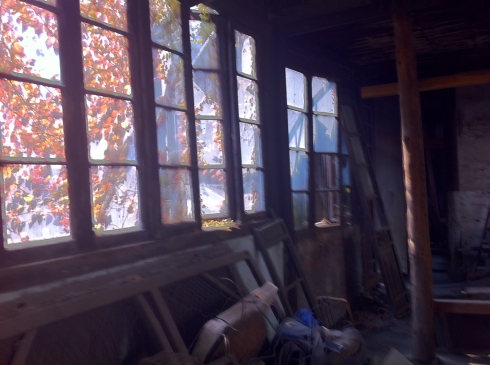Some time last October, I discovered a “walking think tank” called Shanghai Flâneur. It promotes the art, you may say, of walking in the city and, one thing leading to another, I have now started to collaborate with the consultancy attached to it, called Constellations. Shanghai Flâneur organises thematic walks to the wider public, generally urban amateurs or professionals, or more corporate clients as part of a wider programme.
To date, I have been on one walk, which focused on the old city of Shanghai. I was particularly curious as I had previously been with a friend to the old city and, much to my dismay, couldn’t find it! We wandered in-between vast construction sites and tall residential buildings. One or two streets were quite popular and picturesque but that was about it.
The Flâneur talk-walk – twalk is probably the best term for it – was led by Katya Knyazeva, a Russian resident of Shanghai, who became passionate with this part of the city and researched it to the point of becoming an expert and now working on a book dedicated to it. There was a whole lot of fantastic information, historical, urban and human, and the discovery of unsuspected treasures. I have tried to filter some of it here in a comprehensible and palatable way, but excuse me in advance for the length of this post – and this is just a part of Katya’s talk.
The first thing to know is that the origins of Shanghai are actually very modest. As its name indicates, the old city is where it all started. However, it used to be a small fishing town built on wetlands, where some of the streets of today were actually a network of canals leading to the far larger Huangpu river and linked to the hinterland. This is why most of the streets in the old town are winding and curvy, following the geology of the land rather than a set plan. The old city was also fortified and, although the wall is no longer, you can guess its trace in the circular road going around what used to be all of the old town.

Adapted from Google Maps
Not all that was part of the old town remains today. As I mentioned above, there is a lot of new and prospective development around. However, life in the older neighbourhoods is certainly buzzing and full of artefacts witnessing Shanghai’s history. We started off at Penglai Road and got straight into a daily street market. The street was packed with all sorts of products from fresh and ready made foods to clothing. It was difficult to keep your cool with so many curious things going on and the pedestrian traffic in all directions. We started off with some of those winding streets with very modest buildings, some of which are very very old but, due to various alterations and extensions, bear few marks of their historical importance. If I recall correctly, one of the buildings dates as far back as the early 19th century, but you could never ever tell by its appearance as it’s been mended practically everywhere.


The high rises looming in the horizon like a threat

Hand-made pork dumplings


Mending and mending one’s house

Incidentally, this was pyjama land (read this post for more info)
After crossing the market, we carried on to slightly wider streets where more imposing, European-inspired houses fronted the street. Some prominent people lived in this area and their presence is indicated by weird plates to the front of the house, written in Chinese only, which sadly limits the appreciation of their importance. We went through the gates of some of the housing blocks, where we discovered beautiful ornamental details and where Katya told us a little bit about the past and current inhabitants and their misfortunes during the hard core Communist times. Like this 70 year-old lady who was the daughter of a poet’s butler and, just for the mere association of her family with a more bourgeois one, was sent to do forced labour for 17 years in the Xinjiang province (the westernmost province in China where conditions are harsh today and were harsher then).

Curving street





Entrance into a Shikumen
We then carried on into another neighbourhood, passing on the way by three small trees fenced off from the passage. The reason for this is that these trees are officially listed for being something like a 100 or a 150 years old. This neighbourhood was yet a different world. The various houses and occasional restaurant can be accessed by a network of narrow lanes, where cars cannot circulate. Before we reached our destination, we were shown by our guide these wooden pots/boxes, just lying there.

Guess what these are!
Just as I was thinking that they looked quite nice and was wondering whether it would be nice to get one or were used for rice, we were told that they are actually toilet pots! Shanghai may be the wealthiest city of China with an amazing concentration of billionnaires, yet some people still live in houses with no toilets and therefore use these pots, drop them on the street the following day for the “pot cleaning” service to come, empty them, give them a quick rinse and put them back for the owners to use again.
After about an hour and a half of walking, we knocked on a door set in a blank wall and got into what is Shanghai’s best kept secret and the city’s oldest known house. The lady who lives in it is its owner and direct descendent of the original owner, a highly learned ex-bureaucrat, who commissioned the building of the house. Because the owner and Katya know each other, we were able to visit the house, which is in absolute shambles as the owner and her family do not have the means to restore it and the government is lingering on the matter, not seeing the many values of such a house and probably having “grander” plans for the area. The house is organised in three courtyards and throughout the different indoor areas, you can clearly see the remnants of the grandeur of this house, the amazing craftsmanship and how important this family once was. This was further attested by the presence of a “Golden Stone”.

The very fine and detailed sculpted top of the gate to the second courtyard




This “stone” looks like a table with a thick top tile on top of it. In reality, it’s everything but that. A “Golden Stone” is a tile similar to the ones found in the paving of the Forbidden City in Beijing. They were produced in special workshops in Suzhou and the process of their fabrication used to be (and maybe still is) a very well guarded secret. Those who owned one were particularly lucky and wealthy. It’s meant to just stand and never ever be used as a table. The lady told Katya that when the Red Guards came to pillage the house during the Cultural Revolution and heard about the Golden Stone, harassed her father to give them the stone, thinking it was literally made of gold. Being 15-16 year old uneducated boys, they failed to see any value in a large piece of ceramics and that’s how it still remains in the property of the family.

The Golden Stone

The stamp of the factory in Suzhou
The state of the house and courtyard was obviously very sad to see. What was worse was the fact that a Danish practice had managed to solve the puzzle so to say, by looking at every single beam and piece of wood and understand which piece goes where in the overall structure. They proposed to restore the house and found funds for it but the Shanghai Municipality didn’t let them proceed with it for sheer national pride. They argued that such a project could only be undertaken by a Chinese firm…
Equally sad and weird was to see in what conditions the owner lived, especially coming from such a learned family and whose mother is, we were told, a most refined and well-mannered woman. See for yourselves…

The room where the owner lives

In spite of the enlightenment and wonderful discoveries made on this day, the end of the walk had a bit of a bitter taste. It comforted my theory that Communism is responsible for China and Chinese people losing millennia of culture, manners and finesse, which can be seen in the way they live and sometimes act…

The owner with a drawing from her father who re-organised Yu Garden (Yu Yuan), probably the only historic site to see in Shanghai
Tags: Constellations, flanerie, Forbidden City, Golden Stone, Heritage, Historic Shanghai, History, Katya Knyazeva, ladies walking in their pyjamas, Old Town, Oldest building in Shanghai, Oldest house in Shanghai, people walking in their pyjamas, preservation, pyjama ladies, pyjama land, pyjamas, restoration, Shanghai, Shanghai Flaneur, shikumen, Suzhou, toilet pots, twalk


























